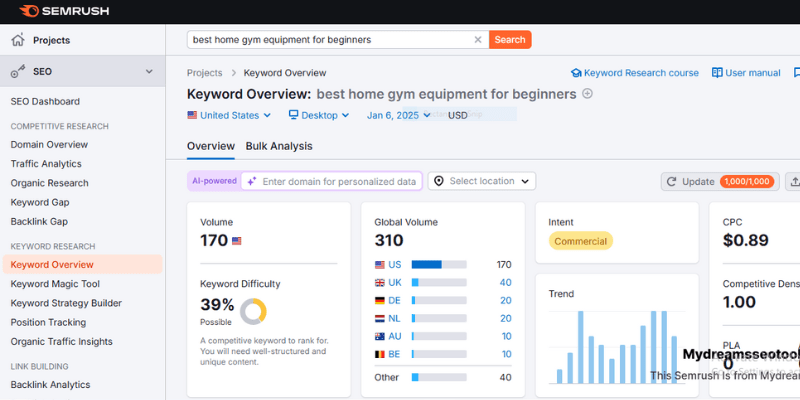How to Find Long-Tail Keywords with Low Competition | SEO Tutorial
Published: 06/Jan/2025
In the world of SEO, knowing how to find long-tail keywords with low competition is one of the most powerful strategies to increase your website’s visibility. While short, broad keywords might seem appealing, they are often too competitive and expensive to target effectively. Instead, long-tail keywords with low competition offer a chance to rank higher and attract highly targeted traffic to your site.
This guide will explore how to find long-tail keywords that can improve your SEO strategy, boost your rankings, and bring in more targeted visitors.

What Are Long-Tail Keywords?
Before diving into the specifics of how to find long-tail keywords, let’s first define what long-tail keywords are. Long-tail keywords are more specific search terms that generally contain three or more words. They are called “long tails” because they make up the “long tail” of the keyword distribution curve.
For example, if your primary keyword is “shoes,” a long-tail variation might be “best-running shoes for flat feet.” This long-tail keyword is much more specific and targets a smaller yet highly relevant audience.
Why Use Long-Tail Keywords with Low Competition?
- Lower competition: Because these keywords are more specific, fewer websites compete for them.
- Higher conversion rates: Searchers using long-tail keywords often know exactly what they want, leading to higher conversion rates.
- Better targeting: Long-tail keywords allow you to speak directly to your target audience’s needs.
If you want to find long-tail keywords with competition, you’re looking for terms that are specific enough to have less competition but still relevant to your audience. This is where SEO tools and research come into play.
How to Find Long-Tail Keywords with Low Competition
Finding long-tail keywords with low competition involves a few simple steps. Here’s how you can do it:
Step 1: Start with a Broad Keyword
First, think about a general keyword that relates to your business or website. For example, if you sell fitness gear, a broad keyword might be “fitness equipment.”
The goal is to start with a general term and then narrow it down into more specific long-tail phrases. For instance, “fitness equipment for home” or “best home gym equipment for beginners” are more specific long-tail versions of the broader keyword.
Step 2: Use Keyword Research Tools

One of the best ways to find long-tail keywords with low competition is to use keyword research tools. These tools can provide insights into the search volume, competition level, and other important metrics. Here are a few tools to help you get started:
- Google Keyword Planner: This is a free tool that helps you explore new keywords related to your business. By entering a broad term, you’ll receive long-tail keyword suggestions with data on their search volume and competition level.
- Ubersuggest: Ubersuggest is another tool that gives you keyword ideas along with competition scores. It also shows you long-tail keywords that you can target for your content.
- Ahrefs and SEMrush: Both of these premium tools provide comprehensive keyword research, allowing you to check the difficulty of different keywords and their ranking potential. These tools are invaluable for finding keywords with low competition that still have a decent search volume.
Pro Tip: Pay attention to the Keyword Difficulty (KD) score in these tools. Ideally, you want to find long-tail keywords that have a KD score below 40. These are often less competitive and can be easier to rank for.
Step 3: Analyze Search Intent
When you are looking to find long-tail keywords, understanding the search intent behind a keyword is crucial. Search intent refers to the reason behind a search query. There are three main types of search intent:
- Informational intent: The user is looking for information (e.g., “how to train a dog”).
- Navigational intent: The user is trying to find a specific website (e.g., “Facebook login”).
- Transactional intent: The user is ready to make a purchase or take some action (e.g., “buy running shoes online”).
To identify long-tail keywords with low competition, you should focus on transactional or informational keywords. These keywords are often specific and reflect a user’s intent to take action or learn more about a topic. Transactional keywords, like “buy organic shoes for flat feet,” often come with lower competition but higher conversion rates.
Step 4: Look for Content Gaps in Your Niche
Another smart way to find low-competition long-tail keywords is to look for content gaps in your niche. Content gaps are topics or questions that people are searching for, but there aren’t many answers to.
To find these gaps:
- Review the content of your competitors. Look at their blog posts, product pages, and FAQs.
- Check for questions or topics that your competitors haven’t addressed thoroughly.
- Use tools like Answer the Public to find questions related to your primary keyword that aren’t well covered by your competitors.
By filling these content gaps with high-quality content, you can rank for long-tail keywords with low competition and attract traffic to your website.
Step 5: Check the Competition
Once you have a list of potential long-tail keywords, it’s time to check the competition. Here’s how you can do that:
- Google the keyword: Search the keyword on Google to see who ranks on the first page. If the top-ranking pages are from smaller or less authoritative websites, that’s a good sign that the competition is low.
- Use SEO Tools: Tools like Ahrefs, SEMrush, and Moz allow you to see the Domain Authority (DA) of the pages ranking for a specific keyword. If the page ranking for the keyword has a low DA, it means the keyword has low competition.
- Look at Search Volume: Don’t be discouraged by keywords with low search volume. Sometimes, keywords with fewer searches are more valuable because they have lower competition and higher conversion rates.
Step 6: Create Quality Content Around Your Keywords
Now that you’ve found your long-tail keywords with low competition, it’s time to create high-quality content around them. Whether you’re writing blog posts, product descriptions, or landing pages, make sure your content is well-researched and directly answers the user’s query.
Here’s an example: If your keyword is “best shoes for flat feet,” create a blog post or product page that answers the following:
- What are flat feet?
- Why certain shoes work better for people with flat feet.
- A list of the best shoes, with detailed descriptions of each pair.
Be sure to incorporate your long-tail keyword naturally throughout the content. This helps search engines understand that your content is relevant to the keyword and increases your chances of ranking.
Conclusion
Finding long-tail keywords with low competition is an essential step in building a successful SEO strategy. By using the right tools, analyzing search intent, and checking the competition, you can uncover keywords that will help you rank higher and attract more targeted traffic to your site.
If you want to find long-tail keywords that bring real results, make sure to focus on low-competition keywords that are relevant to your audience. Follow the steps outlined in this guide, and you’ll be on your way to improving your SEO and growing your website’s traffic.
Ready to get started? Begin with a broad keyword, use keyword tools, and analyze your competition. Before you know it, you’ll have a list of long-tail keywords with low competition that will help you stand out in your niche.
These posts could interest you!
- Why is niche content more effective for digital marketing?
- 5 tools to find easy-to-rank keywords for niche websites





